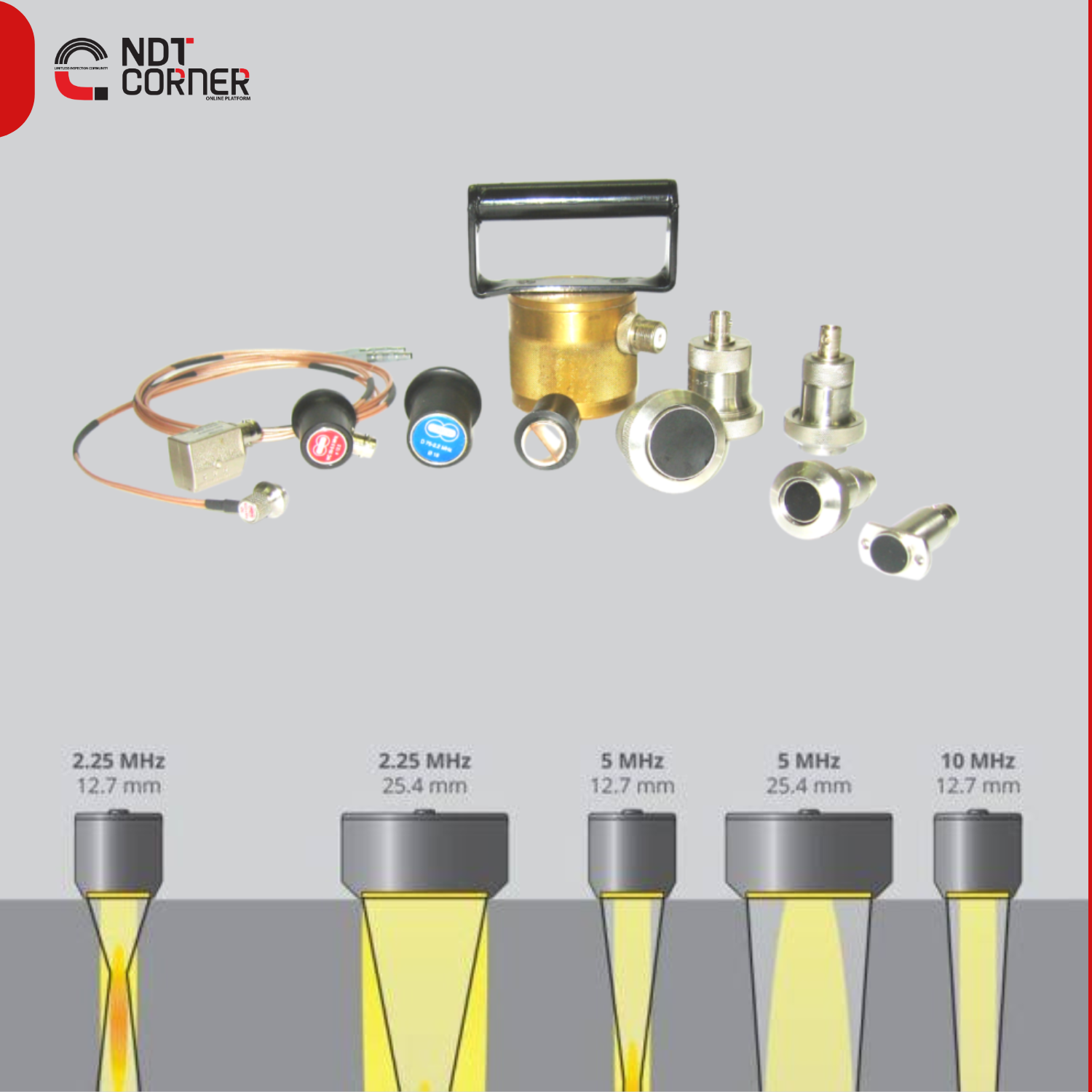
Different Types of Ultrasonic Transducers
24 Nov 2022 Download PDF
Ultrasonic transducers for nondestructive testing use high-frequency sound waves to measure certain parameters. Inspectors use them in a range of industrial applications, including flaw detection, thickness gaging, and weld inspection.
Ultrasonic transducers come in a variety of shapes and sizes, so it can be challenging to identify the right one. To help in determining the transducer that is most appropriate for their typical applications, here’s an overview of five common types of industrial ultrasonic transducers.
1. Dual element transducers
A dual-element transducer consists of two crystal elements housed in the same case, separated by an acoustic barrier. One element generates sound waves, and the other element acts as a receiver.
Here’s how it works: the two elements are angled toward each other to create a V-shaped sound path in the test material. Essentially, the transmit and receive beams cross under the examination surface. This creates a pseudo-focus effect, which enhances resolution in the focal zone.
The increased sensitivity from the pseudo-focus effect is particularly helpful for examining parts with rough backwall surfaces—making these transducers the industry standard for measuring remaining wall thickness in corrosion applications.
Other common applications include:
- Weld overlay and cladding bond/disbond inspection
- Detection of porosity, inclusions, cracks, and laminations in castings and forgings
- Crack detection in bolts and other cylindrical objects
- High-temperature applications
2. Contact transducers
As the name implies, a contact transducer is used for direct contact inspections. This single element transducer has a wear-resistant surface optimized for contact with most metals—making it durable for use in rugged industrial environments.
This transducer type is available in a variety of styles and configurations, such as fingertip for difficult-to-access areas. Inspectors use contact transducers for many applications, including:
As the name implies, a contact transducer is used for direct contact inspections. This single element transducer has a wear-resistant surface optimized for contact with most metals—making it durable for use in rugged industrial environments.
This transducer type is available in a variety of styles and configurations, such as fingertip for difficult-to-access areas. Inspectors use contact transducers for many applications, including:
- Straight beam flaw detection
- Thickness gaging
- Detecting and sizing delaminations
- Inspecting plates, billets, bars, and other metallic and nonmetallic components
- Velocity measurements
3. Angle beam transducers
An angle beam transducer is a single element transducer used with a wedge to introduce a refracted shear wave or longitudinal wave into a test piece. The removable or integral wedge introduces sound at an angle into the part.
Inspectors commonly use angle beam transducers to test weld integrity, because weld inspection requires you to aim sound waves at an angle. Other common industrial applications include flaw detection and crack sizing techniques.
Wedges come in a variety of sizes to meet specific needs. For instance, some wedges offer a shorter approach distance while others are suited for high-temperature applications. You can also customize select wedges to create nonstandard refracted angles and contours.
An angle beam transducer is a single element transducer used with a wedge to introduce a refracted shear wave or longitudinal wave into a test piece. The removable or integral wedge introduces sound at an angle into the part.
Inspectors commonly use angle beam transducers to test weld integrity, because weld inspection requires you to aim sound waves at an angle. Other common industrial applications include flaw detection and crack sizing techniques.
Wedges come in a variety of sizes to meet specific needs. For instance, some wedges offer a shorter approach distance while others are suited for high-temperature applications. You can also customize select wedges to create nonstandard refracted angles and contours.
4. Delay line transducers
A delay line transducer is a single element transducer designed for use with a replaceable delay line. As the name suggests, this transducer introduces a time delay between the generation of the sound wave and the arrival of the reflected waves, helping to improve the near-surface resolution.
The higher transducer frequency is ideal for inspecting or measuring thin materials, as well as locating small flaws while using the direct contact method. With the replaceable delay line, this transducer is well-suited for a variety of industrial applications. Some common applications include:
A delay line transducer is a single element transducer designed for use with a replaceable delay line. As the name suggests, this transducer introduces a time delay between the generation of the sound wave and the arrival of the reflected waves, helping to improve the near-surface resolution.
The higher transducer frequency is ideal for inspecting or measuring thin materials, as well as locating small flaws while using the direct contact method. With the replaceable delay line, this transducer is well-suited for a variety of industrial applications. Some common applications include:
- Precision thickness gaging
- Flaw detection of thin materials
- Inspecting parts with limited contact areas
- High-temperature applications
5. Immersion transducers
An immersion transducer is a single element transducer designed to operate in water. Rather than making direct contact with a test piece, these transducers use a column or bath of water to couple sound energy into the material.
The immersion technique enables uniform, fast coupling so inspectors can quickly scan parts. Inspectors can choose focused transducers to increase sensitivity and performance in a specific area of a part.
Immersion transducers are often used for in-line or in-process tests on moving parts, automated scanning, and optimizing sound coupling into sharp radiuses, grooves, or channels in test pieces with complex geometry. Applications include:
An immersion transducer is a single element transducer designed to operate in water. Rather than making direct contact with a test piece, these transducers use a column or bath of water to couple sound energy into the material.
The immersion technique enables uniform, fast coupling so inspectors can quickly scan parts. Inspectors can choose focused transducers to increase sensitivity and performance in a specific area of a part.
Immersion transducers are often used for in-line or in-process tests on moving parts, automated scanning, and optimizing sound coupling into sharp radiuses, grooves, or channels in test pieces with complex geometry. Applications include:
- In-line thickness gaging
- High-speed flaw detection
- Time-of-flight and amplitude-based imaging
- Material analysis and velocity measurements
- Through-transmission testing
